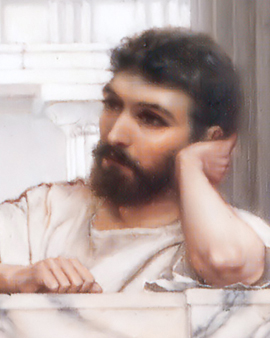John William Godward probably did not have it very easy in his childhood, the bossy nature of his parents made him a reserved and withdrawn man. His choice of profession as an artist was also not well received by the London family of officials. Godward studied architectural drawing, the painter and draughtsman Sir Lawrence Alma Tadema became his patron and so from 1887 he was able to show some of his works at the Royal Academy of Arts. It followed the Royal Society of British Artists and in 1889 the Salon de Paris.
Godward is one of the neo-classical painters of the Victorian age, his style is characterized by classical architecture, ancient Rome, motionless landscapes and marble buildings. His patron also had a strong influence on him; malicious tongues see Godward only as a student of Alma-Tadema. His motifs include not only classical architectural portraits, but also posing women in classicist garments. Nude and semi-nude drawings are less common, but do occur, for example in "Im Tepidarium". When it came to clothing, costumes and architecture, detail and authenticity were important to Godward, which is why he spent much time researching. One of his most famous works is "Dolce far Niente". Godward often made several versions of his works, of which there are three, the 1904 version was bought by Broadway star Andrew Lloyd Webber for his private collection. In this collection is also his probably most famous work "Sweet Nothings". His colour palette, especially for the women's motifs, is mostly powerful and colourful. Godward had made a name for himself through the beautiful women in classical surroundings and his technical mastery. He also ran a painting workshop in London.
In his life Godward also developed a love for Italy, in the country he is said to have been in 1905 for the first time. In 1912 Godward moved there with one of his models, whereupon the family broke off contact. For years he lived in Rome on the grounds of the Villa Strohl-Fern, where many famous artists had their studios rented out by the patron of the arts. During his stay of almost ten years he created, among other works, "The Belvedere". It is said that he also stayed more often in Capri. At the beginning of the 20s he settled back in England for health reasons. He died of suicide a little later, whereupon his family burned all his pictures and papers. In a farewell letter Godward is said to have written that the world was not big enough for him and Pablo Picasso. During the turn to modern art and cubism, Godward saw his work as outdated, he took less and became depressed. Today, his Greco-Roman inspired works and his history painting are well known.
×





.jpg)
.jpg)
.jpg)
.jpg)
.jpg)
.jpg)
.jpg)
.jpg)
.jpg)
.jpg)
.jpg)
.jpg)
.jpg)
.jpg)
.jpg)
.jpg)
.jpg)
.jpg)
.jpg)
.jpg)
.jpg)
.jpg)
.jpg)
.jpg)
.jpg)
.jpg)
.jpg)
.jpg)
.jpg)
.jpg)
.jpg)
.jpg)
.jpg)
.jpg)
.jpg)
.jpg)
.jpg)
.jpg)
.jpg)
.jpg)
.jpg)
.jpg)
.jpg)
.jpg)
.jpg)
.jpg)
_-_(MeisterDrucke-1132678).jpg)
_-_(MeisterDrucke-1132678).jpg)
.jpg)
.jpg)
.jpg)
.jpg)
.jpg)
.jpg)
.jpg)
.jpg)
.jpg)
.jpg)
 - (MeisterDrucke-152496).jpg)
 - (MeisterDrucke-152496).jpg)
.jpg)
.jpg)
.jpg)
.jpg)
.jpg)
.jpg)
.jpg)
.jpg)
.jpg)
.jpg)
.jpg)
.jpg)
.jpg)
.jpg)
.jpg)
.jpg)
.jpg)
.jpg)
.jpg)
.jpg)
.jpg)
.jpg)
.jpg)
.jpg)
.jpg)
.jpg)
.jpg)
.jpg)
.jpg)
.jpg)
.jpg)
.jpg)
_par_Godward_John_William_(1861-1922)_-_(MeisterDrucke-995038).jpg)
_par_Godward_John_William_(1861-1922)_-_(MeisterDrucke-995038).jpg)
_-_(MeisterDrucke-1571868).jpg)
_-_(MeisterDrucke-1571868).jpg)
_-_(MeisterDrucke-1129031).jpg)
_-_(MeisterDrucke-1129031).jpg)
.jpg)
.jpg)
.jpg)
.jpg)
.jpg)
.jpg)
.jpg)
.jpg)
.jpg)
.jpg)
.jpg)
.jpg)
.jpg)
.jpg)
.jpg)
.jpg)
.jpg)
.jpg)
.jpg)
.jpg)
.jpg)
.jpg)
.jpg)
.jpg)
.jpg)
.jpg)
.jpg)
.jpg)
.jpg)
.jpg)
.jpg)
.jpg)
.jpg)
.jpg)
.jpg)
.jpg)
.jpg)
.jpg)
.jpg)
.jpg)
_-_(MeisterDrucke-1133448).jpg)
_-_(MeisterDrucke-1133448).jpg)
.jpg)
.jpg)
.jpg)
.jpg)
.jpg)
.jpg)
.jpg)
.jpg)
.jpg)
.jpg)
.jpg)
.jpg)
.jpg)
.jpg)
.jpg)
.jpg)
.jpg)
.jpg)
.jpg)
.jpg)
.jpg)
.jpg)
.jpg)
.jpg)
.jpg)
.jpg)
.jpg)
.jpg)
_-_(MeisterDrucke-596386).jpg)
_-_(MeisterDrucke-596386).jpg)
.jpg)
.jpg)
.jpg)
.jpg)
.jpg)
.jpg)
.jpg)
.jpg)
.jpg)
.jpg)
.jpg)
.jpg)
.jpg)
.jpg)
.jpg)
.jpg)
.jpg)
.jpg)
.jpg)
.jpg)
.jpg)
.jpg)
.jpg)
.jpg)
_-_(MeisterDrucke-1315772).jpg)
_-_(MeisterDrucke-1315772).jpg)
.jpg)
.jpg)
.jpg)
.jpg)






